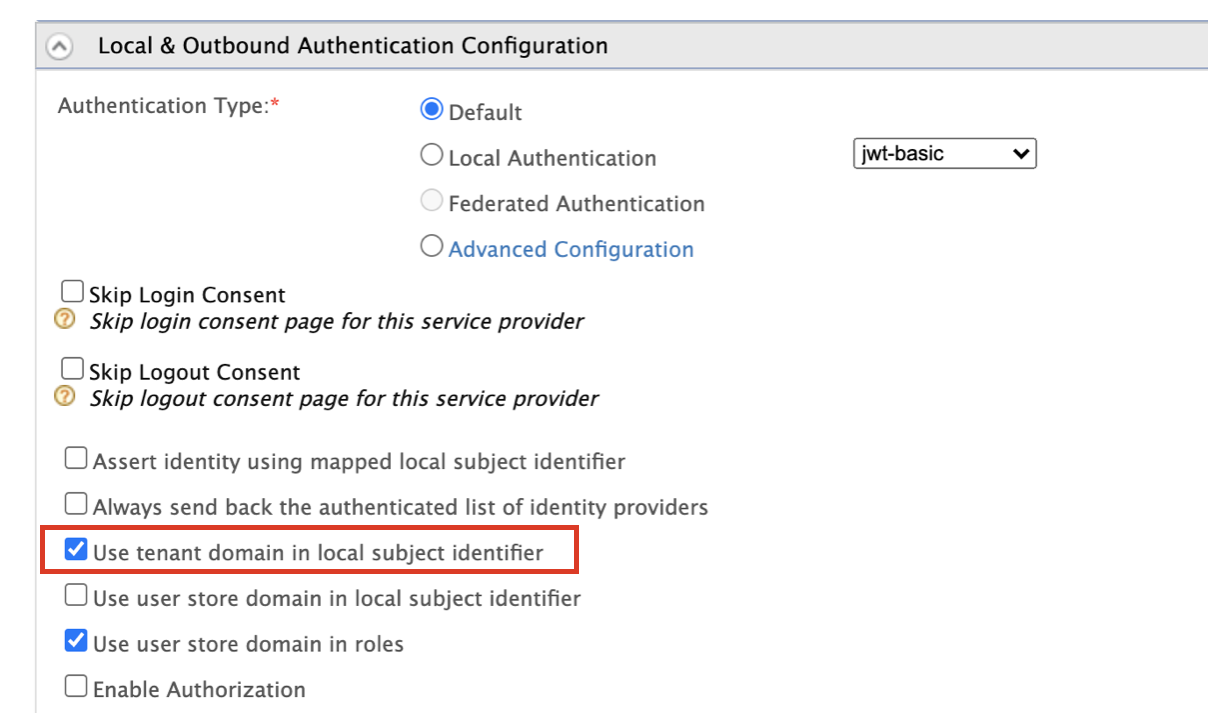OpenID Connect Logout URL Redirection¶
WSO2 Identity Server allows you to construct a logout URL so that an application can redirect to a particular logout page when the relying party (RP) sends an OpenID Connect (OIDC) logout request.
An OIDC logout request is generally a GET request (i.e., you construct a URL with the necessary parameters and perform a redirection).
However, there can be instances where you cannot use a GET request as the OIDC logout request. For example, when the generated id_token exceeds the maximum character limit of the URL, and the browser truncates the URL. In such instances, you can send the logout request as a POST request using an automatically submitting HTML form.
Register a service provider¶
To register your application as a service provider in the WSO2 Identity Server:
-
Log in to the WSO2 Identity Server Management Console using administrator credentials.
-
Go to Main > Identity > Service Providers > Add.
-
Enter a Service Provider Name. Optionally, enter a Description.
-
Click Register.
Configure the service provider¶
Make the following changes to the created service provider.
-
Expand Inbound Authentication Configuration > OAuth/OpenID Connect Configuration.
-
Enter the Callback Url.
Tip
For more information on
Callback Urland other advanced configurations, see Advanced OpenID Connect Configurations. -
Enter a logout URL along with the callback URL.
regexp=(callback_url|logout_url)You can specify multiple callback URLs using a regex pattern as shown below.
Sample
regexp=(http://localhost:8080/playground2/oauth2client|http://localhost:8080/playground2/logout) -
Click Add to save the changes.
Configure to sign the ID token¶
-
Open the
deployment.tomlfile found in the<IS_HOME>/repository/conffolder. -
Add the following configuration.
[authentication] sign_auth_response_with_tenant_of= "sp" #userNote
- If the aforementioned configuration is set to
sp, the JWT is signed with the application tenant key. - If it is set to
user, the tenant is decided by the subject of the id token, though the subject would not contain the tenant domain by default. If the configured option isuser, expand Local & Outbound Authentication Configuration on the management console service provider configuration and select Use tenant domain in local subject identifier.
- If the aforementioned configuration is set to
-
Restart the server.
Send a GET logout request¶
-
Use the following cURL command to retrieve the
id_tokenusing the client ID, client secret, and authorization code.Request Format
curl -k -v --user <client_id>:<client_secret> -d "grant_type=authorization_code&code=<authorization_code>&redirect_uri=<redirect_uri>" https://<IS_HOST>:<IS_PORT>/oauth2/token
Sample Request
curl -k -v --user IaWVc3g4eemSnbWwekBg79xudZMa:PL9PxKPqGZxkpJ8X8u7g8pA_ruoa -d "grant_type=authorization_code&code=ac1b2e9e-d8d0-3f42-bdd4-dc7aab45b5dc&redirect_uri=http://localhost:8080/playground2/oauth2client" https://localhost:9443/oauth2/token -
Use the retrieved
id_tokenin the following URL to logout from the identity provider and redirect to a URL in the relying party (RP).Format
https://localhost:9443/oidc/logout?id_token_hint=<id_token>&post_logout_redirect_uri=<redirect URI>&state=<state>
Sample
https://localhost:9443/oidc/logout?id_token_hint=eyJ4NXQiOiJNell4TW1Ga09HWXdNV0kwWldObU5EY3hOR1l3WW1NNFpUQTNNV0kyTkRBelpHUXpOR00wWkdSbE5qSmtPREZrWkRSaU9URmtNV0ZoTXpVMlpHVmxOZyIsImtpZCI6Ik16WXhNbUZrT0dZd01XSTBaV05tTkRjeE5HWXdZbU00WlRBM01XSTJOREF6WkdRek5HTTBaR1JsTmpKa09ERmtaRFJpT1RGa01XRmhNelUyWkdWbE5nX1JTMjU2IiwiYWxnIjoiUlMyNTYifQ.eyJhdF9oYXNoIjoid3l2dExOU3VMbUpubV9FYVhWM183QSIsImF1ZCI6IllteEQwakRPSWZpQmtEOFRQTFlPZnhOU0lnNGEiLCJzdWIiOiJhZG1pbiIsInVwbiI6ImFkbWluIiwibmJmIjoxNTg3NTQyNDE5LCJhenAiOiJZbXhEMGpET0lmaUJrRDhUUExZT2Z4TlNJZzRhIiwiYW1yIjpbInBhc3N3b3JkIl0sImlzcyI6Imh0dHBzOlwvXC9sb2NhbGhvc3Q6OTQ0M1wvb2F1dGgyXC90b2tlbiIsImdyb3VwcyI6WyJBcHBsaWNhdGlvblwvVXNlciBQb3J0YWwiLCJBcHBsaWNhdGlvblwvcGlja3VwLWRpc3BhdGNoIiwiSW50ZXJuYWxcL2V2ZXJ5b25lIiwiQXBwbGljYXRpb25cL3BpY2t1cC1tYW5hZ2VyIiwiYWRtaW4iLCJBcHBsaWNhdGlvblwvbXAtand0Il0sImV4cCI6MTU4NzU0NjAxOSwiaWF0IjoxNTg3NTQyNDE5fQ.Ibguye1XxPbRgdmpMCAbHn3aNl00NWWpMubg8dKuYrO-7rP7Uh76_5LQqWdzp1dsBuPSqKATnGn95vZ4uz3yn1aB-TlsBqD6gCRc2GWO5Qk-jYfgCRZHLOrFn82f5Eaoc5p99b4lYIat6DAogS2xj3NYu_rbeo1jHDfI-CzY35X9u_w15uSLpwIxa6DPrU-0WhgSTBk_n9UGJKXdYYQipiXheVQZGAGU86IpHfMyOgd6KQrq2HTBsnFjPUSTBE0ifq2ZBGPfYKA9ESCJX2lC6h4wveqEQRkPWEsry4uYECNPyJXqbE2Kt3sLXo537W2rZpkNHL4_mWMGWv_EIdp0BQ&post_logout_redirect_uri=http://localhost:8080/playground2/logout&state=state_1For a description of the parameters included in the URL, see logout request parameters.
Send a POST logout request¶
Sending an OIDC logout request as a POST request is useful in certain scenarios. For example, consider a service provider that builds an HTML page with the required parameters to render a page in a browser. This scenario requires an OIDC logout request sent as a POST request to the logout endpoint.
The following sample HTML form shows the parameters you need to specify when sending an OIDC logout request as a POST request.
Format
<html>
<body>
<p>OIDC_LOGOUT_POST</p>
<form method='post' action='$idp_url'>
<input type='hidden' name='id_token_hint' value='$id_token'/>
<input type='hidden' name='post_logout_redirect_uri' value='$callback'/>
<input type='hidden' name='state' value='$state'/>
<button type='submit'>POST</button>
</form>
<script type='text/javascript'>
document.forms[0].submit();
</script>
</body>
</html>Sample
<html>
<body>
<p>OIDC_LOGOUT_POST</p>
<form method='post' action='https://localhost:9443/oidc/logout'>
<p>
<input type='hidden' name='id_token_hint' value='eyJ4NXQiOiJObUptT0dVeE16WmxZak0yWkRSaE5UWmxZVEExWXpkaFpUUmlPV0UwTldJMk0ySm1PVGMxWkEiLCJraWQiOiJkMGVjNTE0YTMyYjZmODhjMGFiZDEyYTI4NDA2OTliZGQzZGViYTlkIiwiYWxnIjoiUlMyNTYifQ.eyJzdWIiOiJhZG1pbiIsImF1ZCI6WyJuNUFndEFqRmhUZXVybjE4MzhqaTMwbWhUbUFhIl0sImF6cCI6Im41QWd0QWpGaFRldXJuMTgzOGppMzBtaFRtQWEiLCJhdXRoX3RpbWUiOjE1MjIwNTI4NDYsImlzcyI6Imh0dHBzOlwvXC9sb2NhbGhvc3Q6OTQ0M1wvb2F1dGgyXC90b2tlbiIsImV4cCI6MTUyMjA1NjQ0Nywibm9uY2UiOiIxMjMzNDIzNCIsImlhdCI6MTUyMjA1Mjg0N30.g2oSoC_D88XBjN81Lgx0DmOFELO_lXVXTu2YwbZOQGiCJyJLCjwW_Q0UJimBG-ZZIJo5sPj5yrHi5wB9r-Dkr_9QOsgQc7YpiZ0hGw3x53tttxaA655kHuZCsFSJDY7nIsfH-d9Yhi-p4arfdwrrMpcvkwVoLwca1M3-1j9v3LU'/>
<input type='hidden' name='post_logout_redirect_uri' value='https://localhost/callback'/>
<input type='hidden' name='state' value='zzdfdsfdfdfd'/>
<button type='submit'>POST</button>
</p>
</form>
<script type='text/javascript'>
document.forms[0].submit();
</script>
</body>
</html>For a description of the parameters included in the HTML form, see logout request parameters.
Sending logout request with encrypted id_token_hint¶
If the application uses encrypted ID tokens, application needs to send the encrypted ID token as the id_token_hint parameter value.
Since the application's private key is not available in the Identity Server, the application must send the ID token by encrypting it using the public key of the Identity Server after decrypting the obtained ID token using its private key.
For more information, see Encrypting ID tokens.
https://localhost:9443/oidc/logout?id_token_hint=eyJraWQiOiJNamxqT0dWa09UQTBZVE5oWkRCbE9Ea3habUV6WlRNNE5EYzVaakJsTmpRNVptVmpNell3WkRrMk5HWmtNVGcxTnpjM1lXRmlOamN3TWpGaE9UUmtZdyIsImN0eSI6IkpXVCIsImVuYyI6IkExMjhHQ00iLCJhbGciOiJSU0EtT0FFUCJ9.c1Avz5QLNP36V1rDTPFfwRz2B0NEJkUUQPPTb3ZrjYpCoDqFz8BGj2dft0ERMtEm3mkHfFpwCL18bEU4TQ8-z-8iRjk1QbeSZ0H91gFn15adpe52N2yjpt7aqsXqqiVW158d7-eFesYUWSVwhQEJNkvN03MvYzgkDY2fe-sRdhaNBfgGYh1NSXzhC_HEzFpD4lyTcvt-jgtG7SldLjBwe6NPF8w_bnjPSYtIYVJl9f-PbgqSsmVjp_0cNh-xDXwBOOHGeakFcgThBR09-Zf9w2ScuPdURYo2quRq29dLiLgLLQ7kpzZrY0RKTevS41_CTTCyZa8qCy0MinU1Y9Mwxg.P_6JJrBI93sPuheb.VcurLlExdNhp18I5K8xcLLdgBT71mFrAuwXB8kalhoopKAyTsz6FS-ZB5wxeT1U0loDqNTGLYp6dgBYoIty-JlICHKxxk45x6hJ5fIEgJQQUEO-cCGrTqAYGy0R8_SyyLYo4zFuREsX1TTFyDNgyqmy9perjCNcJT_2I_FoBsQdisGdAW6NcubVrLerYXFgOO_7AviThr3V6OXxiDiaBIhI8wJ81uw53G5Yql5WncYnjV4PHppf57nGTjjHNK_BiYCZ1uirBr78JULczsKi2bJo1j2XpGJMKkxLlS5IKUBtCUfimhTDjEFi7r5s1_FR5NTGdM-E2XwcC6tpLjFRF5J-GsaHNQYdLW2ipPFbqqYXXnKTi2-mZtKAoj3Q_7OFHu6CdabUK_jFp_d38o7aLkRAeSnI4RyyDw9CAAAb5CDrWSyB3Ba1Ab_w4oEv2f5csfC49rSRyRCXxdQ-Ky166y_kAyJ7UfAUsz-tKADtIcITXB6QlT1Xcdv3vNt49ZVv7elm-Onpw2KoiFAitA4FPqFERxTyxDIWF6LNQjDbeno_kWaWgeMEFwlDL7fja5oIoHn1tISF2G_S1y1pouEJld-bkX5nrh4cQMG6bHLsRfgkN1nbOPxgfDF13zq33dhMY.8xj0exlMO0tL9NDKibFbsQ
&post_logout_redirect_uri=http%3A%2F%2Flocalhost%3A8080%2Fplayground&tenant_domain=carbon.super Logout request parameters¶
| Parameter | Description | Required |
|---|---|---|
idp_url |
The OIDC logout endpoint URL. | Yes |
client_id |
The client ID obtained when registering the application in WSO2 Identity Server.
Note To use the |
Yes (if the id_token_hint is not included) |
id_token_hint |
The id_token returned by the identity provider. |
Yes (if the client_id is not included) |
post_logout_redirect_uri |
The URL to be redirected to when logging out. The value defined here should be the same as the Note If you do not specify a value for the |
Yes |
state |
The parameter passed from the application to the identity provider to maintain any state information. This is used to correlate the logout requests and responses. If the state parameter is defined as state_1 , the logout request and response both have state_1 in them. This makes it easy for the client to identify the request and responses. |
No |
tenant_domain |
When an application sends an encrypted id_token_hint (encrypted from the WSO2 IS public certificate) in the logout flow, it should send tenant domain also as a query param. | No |
Related topics